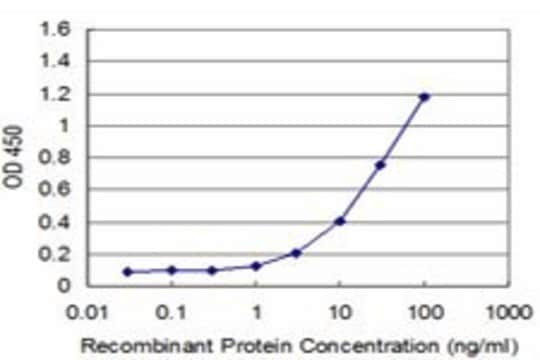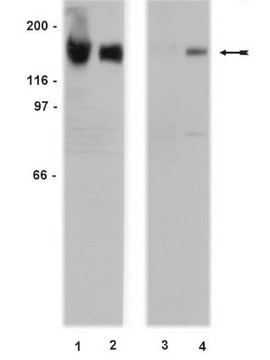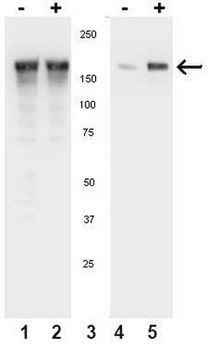07-819
Anti-phospho-EGFR (Tyr1148) Antibody
Upstate®, from rabbit
Sign Into View Organizational & Contract Pricing
All Photos(1)
About This Item
UNSPSC Code:
12352203
eCl@ss:
32160702
NACRES:
NA.41
Recommended Products
biological source
rabbit
Quality Level
antibody form
affinity isolated antibody
antibody product type
primary antibodies
clone
polyclonal
purified by
affinity chromatography
species reactivity
human
manufacturer/tradename
Upstate®
technique(s)
western blot: suitable
NCBI accession no.
UniProt accession no.
shipped in
dry ice
target post-translational modification
phosphorylation (pTyr1148)
Gene Information
human ... EGFR(1956)
Specificity
Predicted to cross-react with mouse and rat based on sequence homology (100%), but have not been tested.
Recognizes phospho-EGFR (Tyr1148)
Immunogen
Peptide corresponding to amino acid region encompassing the human, mouse, and rat phospho-EGFR (Tyr1148)
Application
Immunoblot Analysis: A 1:1000 dilution of this lot detected phospho-EGFR (Tyr1148) in RIPA lysates from EGF stimulated A431 cells.
Research Category
Signaling
Signaling
Research Sub Category
Growth Factors & Receptors
Growth Factors & Receptors
This Anti-phospho-EGFR (Tyr1148) Antibody is validated for use in WB for the detection of phospho-EGFR (Tyr1148).
Quality
Routinely evaluated by immunoblot.
Target description
185 kDa
Physical form
100 μl of affinity purified rabbit polyclonal IgG in 50% storage buffer (PBS (without Mg2+ and Ca2+), pH 7.3 containing 1.0 mg/mL BSA (IgG, protease free) and 0.05% sodium azide) and 50% glycerol.
ImmunoAffinity Purified
Storage and Stability
Stable for 2 years at -20°C from date of shipment.
Handling Recommendations: Upon first thaw, and prior to removing the cap, centrifuge the vial and gently mix the solution. Aliquot into microcentrifuge tubes and store at -20°C. Avoid repeated freeze/thaw cycles, which may damage IgG and affect product performance. Note: Variability in freezer temperatures below -20°C may cause glycerolcontaining solutions to become frozen during storage.
Handling Recommendations: Upon first thaw, and prior to removing the cap, centrifuge the vial and gently mix the solution. Aliquot into microcentrifuge tubes and store at -20°C. Avoid repeated freeze/thaw cycles, which may damage IgG and affect product performance. Note: Variability in freezer temperatures below -20°C may cause glycerolcontaining solutions to become frozen during storage.
Legal Information
UPSTATE is a registered trademark of Merck KGaA, Darmstadt, Germany
Disclaimer
Unless otherwise stated in our catalog or other company documentation accompanying the product(s), our products are intended for research use only and are not to be used for any other purpose, which includes but is not limited to, unauthorized commercial uses, in vitro diagnostic uses, ex vivo or in vivo therapeutic uses or any type of consumption or application to humans or animals.
Not finding the right product?
Try our Product Selector Tool.
Storage Class
12 - Non Combustible Liquids
wgk_germany
WGK 2
flash_point_f
Not applicable
flash_point_c
Not applicable
Certificates of Analysis (COA)
Search for Certificates of Analysis (COA) by entering the products Lot/Batch Number. Lot and Batch Numbers can be found on a product’s label following the words ‘Lot’ or ‘Batch’.
Already Own This Product?
Find documentation for the products that you have recently purchased in the Document Library.
Changes in retinal cell fate induced by overexpression of EGF receptor
Lillien, L.
Nature, 377, 158-162 (1995)
Polymorphonuclear leukocytes-mediated lysis of A431 cells induced by IgG1 mouse anti-epidermal growth factor receptor monoclonal antibodies.
Kawamoto, T, et al.
In Vitro Cellular & Developmental Biology, 28A, 782-786 (1992)
Wojciech Stec et al.
Oncotarget, 9(9), 8560-8572 (2018-03-02)
Despite intensive research no therapies targeted against the oncogenic EGFRvIII are present in the clinic. One of the reasons is the elusive nature of the molecular structure and activity of the truncated receptor. The recent publications indicate the EGF-bound wild-type
G R Johnson et al.
The Journal of biological chemistry, 268(4), 2924-2931 (1993-02-05)
The COOH-terminal half of the amphiregulin (AR) molecule has sequence homology to epidermal growth factor (EGF). The ability of AR to elicit in vivo phosphorylation of the EGF receptor (EGFR) and p185erbB2 was studied in four human epithelial cell lines
Cytotoxic properties of DAB486EGF and DAB389EGF, epidermal growth factor (EGF) receptor-targeted fusion toxins.
Shaw, J P, et al.
The Journal of Biological Chemistry, 266, 21118-21124 (1991)
Our team of scientists has experience in all areas of research including Life Science, Material Science, Chemical Synthesis, Chromatography, Analytical and many others.
Contact Technical Service








